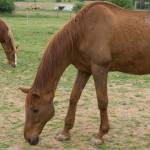Dental Issues and Weight Gain in Aged Horses

Equine odonotoclastic tooth resorption and hypercementosis (EOTRH) is characterized by diseased dental structures and an overproduction of cementum on the exterior of teeth. Cementum is a calciferous material that normally covers the root of the tooth. As the disease progresses, teeth become inflamed and often infected, leading to severe dental problems, pain, and inappetence. EOTRH is generally diagnosed in horses over 15 years of age.
The diagnosis of EOTRH makes formulating a nutrition plan for horses difficult, but the goal of weight gain starts with a single premise: increase digestible energy needs to be greater than energy expenditure.
When encouraging weight gain, it is important to make sure horses have adequate forage in front of them at all times. Horses require a minimum of 1.5-2% of their body weight in forage daily. Free-choice access to high-quality forage is the best way to maximize forage intake in the diet.
Long-stem alfalfa (lucerne) is a good choice for underweight horses because of its higher protein and energy content. A soft, leafy alfalfa would likely work well for most horses with dental issues. Try to find hay that is loaded with leaves that are well anchored to stems, as leaves provide the most concentrated source of energy in a hay plant.
Some clever horses with EOTRH become adept at grasping forage with their lips and then transferring it to the back of the mouth where it is ground by molars, bypassing the incisors, or front teeth, and avoiding potential pain. These horses tend to do well on long-stem forage, at least until the disease is in an advanced state. If, however, you notice that a horse has difficulty grasping hay or drops half-chewed hay from its mouth, then other forages are necessary.
Appropriate alternative forage sources include chaff, hay pellets, and hay cubes. Forage cubes and pellets can be offered, soaked if necessary. Horses with normal teeth will often use their incisors to break up hay cubes. Because horses with EOTRH sometimes have painful incisors, forage cubes, which tend to be hard and difficult to chew, may have to be soaked thoroughly, to the point of becoming mushy, before feeding. While most horses will readily eat soaked, or even watery, meals, some are more finicky than others. Owners of these horses may try concocting meals of different consistencies to satisfy their horses’ preferences.
Having a bucket of soaked or dampened forage available at all times is ideal for underweight horses, though environmental conditions, namely heat and humidity, might make this difficult as these meals may spoil if not eaten in a timely fashion.
The contribution of pasture to a horse’s diet depends on pasture quality and the ability of the horse to graze. Horses with EOTRH often have diseased or missing incisors, which can make grazing impossible, thus elevating the need for alternative forage sources.
Once the forage component of the diet has been sorted, a high-calorie complete feed might be appropriate for horses with EOTRH. Complete feeds are designed to be fed in large amounts because they include easy-to-chew and especially digestible forage sources. These feeds are particularly useful for thin horses with dental problems. Follow the manufacturer’s recommendations as to how much to feed each day. Divide the total amount into as many meals as possible, with the goal of three or four meals.
In addition to the complete feed, adding vegetable oil or stabilized rice bran will boost calorie consumption. Make any changes to the diet gradually, typically over several days, to allow the horse to become accustomed to new feed ingredients.








